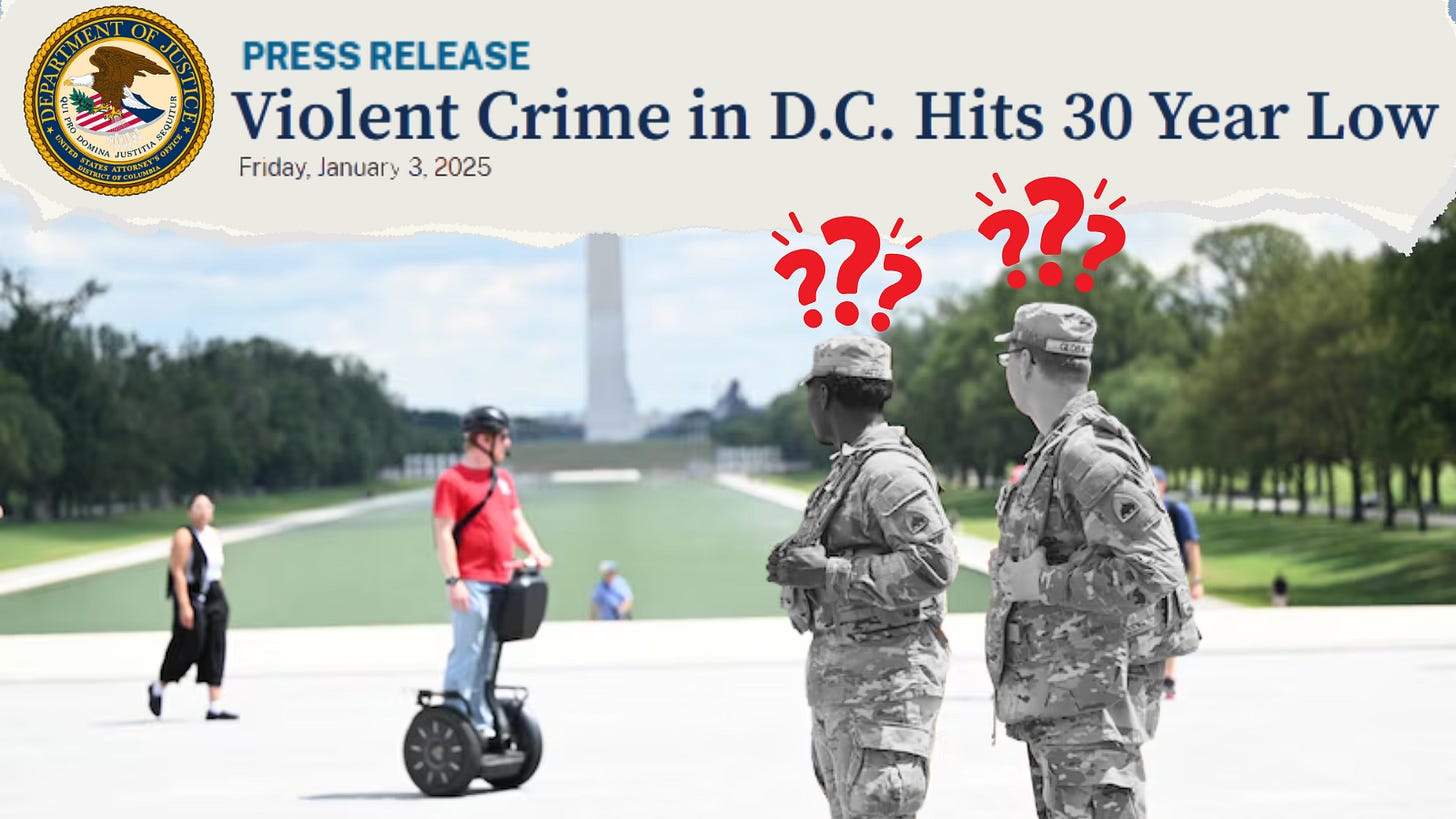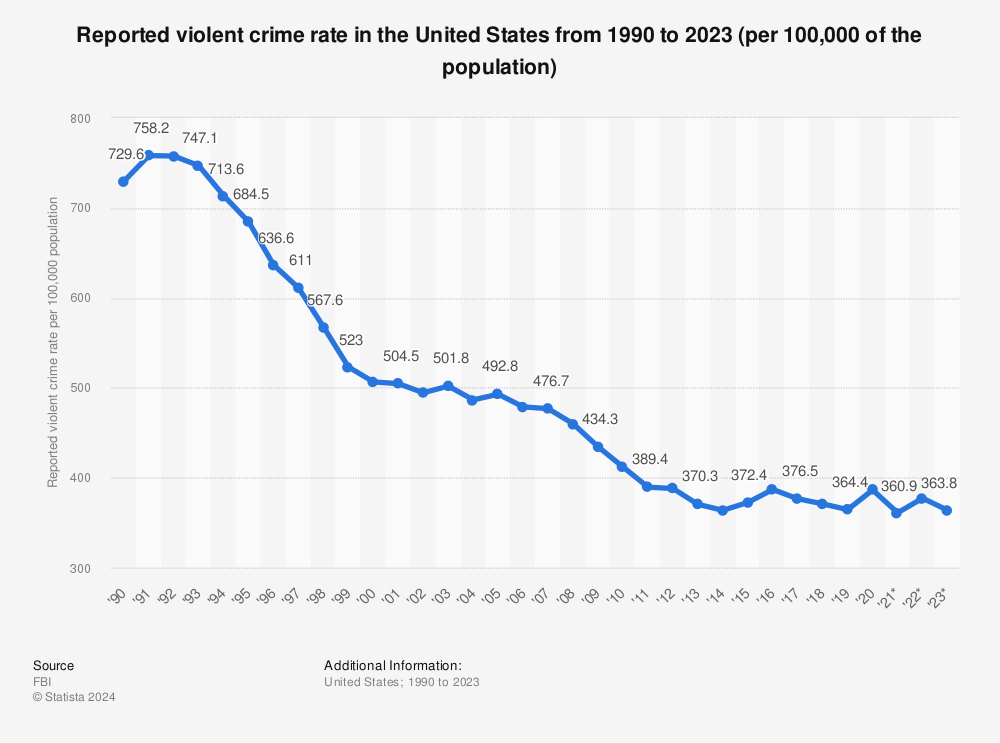Donald Trump’s reign of authoritarian terror began 2 weeks ago when his administration declared martial law over the District of Columbia—deploying the DC National Guard, federalizing the police force, and flooding the streets with FBI, DEA, ATF, ICE, and other federal agencies. His justification? To curb what he claimed was “one of the Highest Rates of Crime in the World, more than many of the most violent Third World Countries” with a “Homicide Rate… higher than places notorious for their violence, such as Mexico City, Bogota, Islamabad, and Addis Ababa — almost ten times higher than Fallujah, Iraq.”
If you believed him, you’d think DC was a post-apocalyptic wasteland—tires rolling down the street on fire, bodies piling up in the Reflecting Pool, every corner a kill zone.
But the actual numbers told a very different story. In January 2025, U.S. Attorney Matthew M. Graves reported that “total violent crime for 2024 in the District of Columbia is down 35% from 2023 and is the lowest it has been in over 30 years,” according to Metropolitan Police Department data:
Homicides: down 32%
Robberies: down 39%
Armed carjackings: down 53%
Assaults with dangerous weapons: down 27%
Yet if you turn on Fox News, Newsmax, Breitbart, or scroll Truth Social, you’d never know it. Fear sells, and for right-wing media, the truth is optional.
The Crime Perception Problem
Humans have always been drawn to violence in storytelling—Shakespeare knew it, as do Netflix producers and true crime podcasters. But in an era when news alerts hit our phones in seconds, that fascination has metastasized into a distorted sense of reality.
Fifty percent of all news coverage focuses on violent crime because “If it bleeds, it leads.” The result: more than 60% of Americans believe crime is worse than ever, despite decades of decline.
This disconnect isn’t new. In the 1970s, local “action news” stations—supercharged by live broadcast technology—shifted from public affairs toward sensationalized crime coverage. The ratings were great. The journalism? Not so much.
Case in point: from 1993 to 1996, the national murder rate dropped 20%. But murder stories on ABC, NBC, and CBS nightly news jumped 721%.
Even today, the average American has only a 2.35% chance of being a victim of a violent crime, but you are 25 times more likely to see crime on TV than to experience it. Nationally, violent crime has dropped from 79.8 incidents per 1,000 people in 1993 to 23.5 in 2022.
Fear is a Powerful Motivator
For Trump, facts didn’t matter. One violent attack on a member of DOGE was enough to justify militarizing the capital—a city that’s majority-minority, historically known as “Chocolate City,” and denied full federal representation.
This is the same fear tactic we saw in 1988, when George H.W. Bush weaponized the case of William “Willie” Horton, a furloughed prisoner escapee from Massachusetts in 1986 who committed rape and homicide in Maryland a year later. Out of 8,896 furloughs granted in Massachusetts in 1986, only 11 resulted in escapes—a 0.12% rate. But relentless ads made it seem as if every furloughed prisoner was a ticking time bomb.
The GOP runs the same playbook today, tying crime to immigration. Trump’s 2015 campaign opener smeared undocumented immigrants as criminals. But Texas DPS data—funded by the National Institute for Justice—shows they’re arrested for violent and drug crimes at less than half the rate of native-born citizens, and for property crimes at one-fourth the rate.
The Democratic Overcorrection
Fear works—61% of voters say crime is a top issue, and for Trump’s 2024 voters, that jumps to 76%. And because crime has been married to immigration despite the lack of solid evidence, immigration has an even larger vote share now with 82% of Trump’s voters in 2024. That is up 21 points from 2020. This has spooked some Democrats into overcorrection.
The same “old guard” who once knelt in Kente cloth at BLM protests now lean into “tough on crime” rhetoric, as though one election loss means our entire justice reform agenda caused chaos in the streets.
Virginia is a prime example. Despite a violent crime rate far below the national average, GOP attacks—like the “Soft Jay Jones” smear site or Lt. Gov. Winsome Sears’ warning of “lawless insanity” under Abigail Spanberger or John Reid claiming there are “Clandestine School-Funded Abortions” in Fairfax County Public Schools —have nudged Democrats into more cop-heavy ads. Some of these ads are being run in Black neighborhoods, which one Richmond activist called “troubling and tone-deaf.”
We’ve seen this backfire before. The 1994 Crime Bill, the most “tough on crime” legislation Democrats ever passed, still haunts the party—damaging Hillary Clinton in 2016 and Joe Biden in 2024. Overcorrection can erode both our values and our base.
And sometimes, this overcorrection can force Democrats themselves to cause the mess. In DC, Mayor Muriel Bowser’s administration cleared one of the city’s largest homeless encampments under K Street without providing shelter alternatives. People simply scattered to other neighborhoods. A housing-first approach could have addressed the problem without playing into conservative narratives about “Democrat-run cities.”
Resisting the Fear Trap of Being “Tough on Crime”
We are in one of the safest periods in modern U.S. history. Democrats don’t need to cosplay authoritarian “law and order” politics to prove they care about safety.
We can:
Address root causes like poverty, housing, and education.
Reform immigration policy with facts, not fear.
Communicate real statistics and long-term strategies.
The GOP thrives on manufacturing crises. Our job isn’t to join their theater—it’s to show that true safety comes from stability, not scapegoating. That’s not just good politics. It’s the truth.
TL;DR
Conservative politicians and media have long used fear—especially about crime—to push authoritarian policies, even when crime rates are historically low. Trump’s militarization of DC in 2025 is the latest example, built on exaggerated and false claims. Sensationalized news coverage fuels public misperception, making voters think crime is worse than it is, and Republicans tie it to issues like immigration despite contrary data.
Some Democrats, spooked by GOP attacks, overcorrect with “tough on crime” messaging that undermines progressive values and echoes past mistakes like the 1994 Crime Bill. Real safety comes from addressing root causes—housing, poverty, education—not from authoritarian crackdowns. Democrats should resist playing into fear-based narratives and instead focus on data-driven, long-term solutions that actually make communities safer
By the Ballot is an opinion series published on Substack. All views expressed are solely those of the author and should not be interpreted as reporting or objective journalism or attributed to any other individual or organization. I am not a journalist or reporter, nor do I claim to be one. This publication represents personal commentary, analysis, and opinion only.






yes